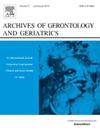Influencing factors for multi-dimensional frailty of older adults in community: A systematic review and meta-analysis
IF 3.5
3区 医学
Q2 GERIATRICS & GERONTOLOGY
引用次数: 0
Abstract
Objective
To systematically evaluate the factors associated with multidimensional frailty assessed by the Tilburg Frailty Indicator among community-dwelling older adults.
Methods
A computerized search was conducted on ten databases, including CNKI, WanFang, VIP, CBM, PubMed, Web of Science, Embase, Scopus, Cochrane Library, and CINAHL, covering studies from inception to December 3, 2024. Literature screening, quality assessment, and data extraction were performed independently by two investigators, and meta-analysis was performed using STATA 18 software. The quality of the evidence was evaluated using the Grading of Recommendations, Assessment, Development and Evaluation (GRADE) approach.
Results
A total of 28 articles with 138,924 participants were included, and 18 influencing factors were extracted. Meta-analysis results showed that: aged(OR=1.19), female(OR=1.53), marital status(no spouse) (OR=2.02), rural residence (OR=1.32), low education level(OR=2.53), fear of falling (OR=5.38), drinking (OR=1.20), smoking(OR=1.12), unhealthy lifestyle (OR=2.52), sleep disorders (OR=2.40), depression(OR=1.52), chronic diseases (OR=2.06), comorbidity (OR=2.08), self-rated poor health(OR=1.89), and hospitalization (OR=1.34) were risk factors for multidimensional frailty in community-dwelling older adults. Satisfaction with living conditions(OR=0.22), physical activity (OR=0.74), and consumption of tea (OR=0.53)were protective factors.
Conclusion
There are many factors involved in the incidence of multidimensional frailty in community-dwelling older adults by a meta-analysis. Screening for multidimensional frailty in community-dwelling older adults can be carried out early based on their risk factors, and corresponding measures can be taken according to the factors that can be intervened in order to delay or reduce the multidimensional frailty in community-dwelling older adults.
社区老年人多维虚弱的影响因素:系统回顾和荟萃分析
目的系统评价蒂尔堡衰弱指数评价的社区老年人多维衰弱的相关因素。方法计算机检索中国知网、万方、维普、CBM、PubMed、Web of Science、Embase、Scopus、Cochrane Library、CINAHL等10个数据库,涵盖从建库到2024年12月3日的研究。文献筛选、质量评估和数据提取由两位研究者独立完成,使用STATA 18软件进行meta分析。采用推荐、评估、发展和评价分级(GRADE)方法评价证据的质量。结果共纳入文献28篇,受试者138924人,提取影响因素18个。meta分析结果显示:年龄(OR=1.19)、女性(OR=1.53)、婚姻状况(无配偶)(OR=2.02)、农村居住(OR=1.32)、受教育程度低(OR=2.53)、害怕跌倒(OR=5.38)、饮酒(OR=1.20)、吸烟(OR=1.12)、生活方式不健康(OR=2.52)、睡眠障碍(OR=2.40)、抑郁(OR=1.52)、慢性病(OR=2.06)、共病(OR=2.08)、自我评价健康状况不佳(OR=1.89)、住院(OR=1.34)是社区居住老年人多维虚弱的危险因素。对生活条件的满意度(OR=0.22)、身体活动(OR=0.74)和饮茶(OR=0.53)是保护因素。结论荟萃分析表明,社区老年人多维虚弱的发生与多种因素有关。可根据社区居住老年人的危险因素,及早开展社区居住老年人多维脆弱性筛查,并根据可干预的因素采取相应措施,延缓或减轻社区居住老年人多维脆弱性。
本文章由计算机程序翻译,如有差异,请以英文原文为准。
求助全文
约1分钟内获得全文
求助全文
来源期刊
CiteScore
7.30
自引率
5.00%
发文量
198
审稿时长
16 days
期刊介绍:
Archives of Gerontology and Geriatrics provides a medium for the publication of papers from the fields of experimental gerontology and clinical and social geriatrics. The principal aim of the journal is to facilitate the exchange of information between specialists in these three fields of gerontological research. Experimental papers dealing with the basic mechanisms of aging at molecular, cellular, tissue or organ levels will be published.
Clinical papers will be accepted if they provide sufficiently new information or are of fundamental importance for the knowledge of human aging. Purely descriptive clinical papers will be accepted only if the results permit further interpretation. Papers dealing with anti-aging pharmacological preparations in humans are welcome. Papers on the social aspects of geriatrics will be accepted if they are of general interest regarding the epidemiology of aging and the efficiency and working methods of the social organizations for the health care of the elderly.

 求助内容:
求助内容: 应助结果提醒方式:
应助结果提醒方式:


